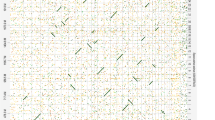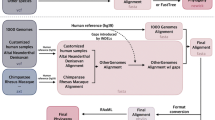Abstract
We have compared the synteny block organization of the official macaque genome sequence assembly (Jan. 2006; rheMac2) with an independent assembly that used a molecular cytogenetic approach. The mapping of four synteny segments, ranging in size from 4 Mb to 24 Mb, was found to be inconsistent between the two datasets. We specifically investigated these discrepancies by appropriate co-hybridization FISH experiments with validated reference probes located outside the area under study. We found that in the macaque rheMac2 release three synteny segments were wrongly mapped and one segment was incorrectly oriented.
Similar content being viewed by others
References
Dobigny G, Yang F, O’Brien PC et al. (2005) Low rate of genomic repatterning in Xenarthra inferred from chromosome painting data. Chromosome Res 13: 651–663.
Gibbs RA, Rogers J, Katze MG et al. (2007) Evolutionary and biomedical insights from the rhesus macaque genome. Science 316: 222–234.
Green P (1997) Against a whole-genome shotgun. Genome Res 7: 410–417.
Ijdo JW, Baldini A, Ward DC et al. (1991) Origin of human chromosome 2: an ancestral telomere-telomere fusion. Proc Natl Acad Sci U S A 88: 9051–9055.
Kurtz S, Choudhuri JV, Ohlebusch E et al. (2001) REPuter: the manifold applications of repeat analysis on a genomic scale. Nucleic Acids Res 29: 4633–4642.
Lander ES, Linton LM, Birren B et al. (2001) Initial sequencing and analysis of the human genome. Nature 409: 860–921.
Lichter P, Tang Chang C-J, Call K et al. (1990) High resolution mapping of human chromosomes 11 by in situ hybridization with cosmid clones. Science 247: 64–69.
McPherson JD, Marra M, Hillier L et al. (2001) A physical map of the human genome. Nature 409: 934–941.
Marshall OJ, Chueh AC, Wong LH et al. (2008) Neocentromeres: new insights into centromere structure, disease development, and karyotype evolution. Am J Hum Genet 82: 261–282.
Marzella R, Viggiano L, Miolla V et al. (2000) Molecular cytogenetic resources for chromosome 4 and comparative analysis of phylogenetic chromosome IV in great apes. Genomics 63: 307–313.
Moore CM, Janish C, Eddy CA et al. (1999) Cytogenetic and fertility studies of a rheboon, rhesus macaque (Macaca mulatta) × baboon (Papio hamadryas) cross: further support for a single karyotype nomenclature. Am J Phys Anthropol 110: 119–127.
Murphy WJ, Fronicke L, O’Brien SJ et al. (2003) The origin of human chromosome 1 and its homologs in placental mammals. Genome Res 13: 1880–1888.
Murphy WJ, Agarwala R, Schaffer AA et al. (2005) A rhesus macaque radiation hybrid map and comparative analysis with the human genome. Genomics 86: 383–395.
Rocchi M, Archidiacono N, Stanyon R (2006) Ancestral genomes reconstruction: an integrated, multi-disciplinary approach is needed. Genome Res 16: 1441–1444.
Rogers J, Garcia R, Shelledy W et al. (2006) An initial genetic linkage map of the rhesus macaque (Macaca mulatta) genome using human microsatellite loci. Genomics 87: 30–38.
Stanyon R, Rocchi M, Capozzi O et al. (2008) Primate chromosome evolution: ancestral karyotypes, marker order and neocentromeres. Chromosome Res 16: 17–39.
Szamalek JM, Goidts V, Cooper DN et al. (2006) Characterization of the human lineage-specific pericentric inversion that distinguishes human chromosome 1 from the homologous chromosomes of the great apes. Hum Genet 120: 126–138.
Ventura M, Archidiacono N, Rocchi M (2001) Centromere emergence in evolution. Genome Res 11: 595–599.
Ventura M, Mudge JM, Palumbo V et al. (2003) Neocentromeres in 15q24–26 map to duplicons which flanked an ancestral centromere in 15q25. Genome Res 13: 2059–2068.
Ventura M, Weigl S, Carbone L et al. (2004) Recurrent sites for new centromere seeding. Genome Res 14: 1696–1703.
Ventura M, Antonacci F, Cardone MF et al. (2007) Evolutionary formation of new centromeres in macaque. Science 316: 243–246.
Wienberg J, Stanyon R, Jauch A et al. (1992) Homologies in human and Macaca fuscata chromosomes revealed by in situ suppression hybridization with human chromosome specific libraries. Chromosoma 101: 265–270.
Yunis JJ, Prakash O (1982) The origin of man: a chromosomal pictorial legacy. Science 215: 1525–1530.
Author information
Authors and Affiliations
Corresponding author
Rights and permissions
About this article
Cite this article
Roberto, R., Misceo, D., D’Addabbo, P. et al. Refinement of macaque synteny arrangement with respect to the official rheMac2 macaque sequence assembly. Chromosome Res 16, 977–985 (2008). https://doi.org/10.1007/s10577-008-1255-1
Received:
Revised:
Accepted:
Published:
Issue Date:
DOI: https://doi.org/10.1007/s10577-008-1255-1




